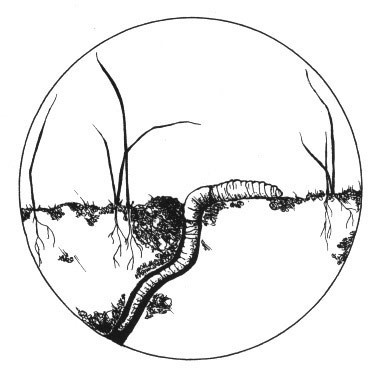
Charles Darwin was fascinated by earthworms. In the 19th century most people thought worms were pests. But Darwin believed they provided an important yet unrecognized agricultural service: they slowly turned over the soil, enhanced decomposition and provided nutrients through their castings.
Darwin conjured up an experiment to prove that worms were major soil movers. He placed pieces of coal across a field behind his country estate outside of London and waited patiently. Two or three decades later he found the coal was completely buried. As Darwin theorized, earthworms added a layer of digested matter on the surface of the earth bit by bit.
While all this might have been good for Darwin’s agricultural field where earthworms were native, modern-day scientists have found that earthworms are not so good for the hardwood forests. In forests of the glaciated Northeast, earthworms are now considered an invasive pest.
Some 12,000 years ago, as the continental ice sheet retreated, not an earthworm was to be found in our region. None had survived under the thick ice that had covered the land for thousands of years. Today, on the East Coast, native worm species are found only to the south, in New Jersey and southern Pennsylvania, areas not reached by the ice sheet. Other forms of life returned to the bare land, but earthworm populations, moving slowly, could advance only about five yards per year. After 12,000 years they could only have crawled north about 28 miles.
Enter the European invasion. Earthworms hitched a ride from the Old World, most likely in the soil used as ballast in the ships that brought colonists. In the New World earthworms found a hospitable environment. Today, humans are still transporting them to new areas—through the dumping of unused fishing bait, by transporting compost and mulch and by moving topsoil. Researchers have found that New England forests now have as many as 15 species of European and Asian earthworms. Biologists are just beginning to understand the ramifications, but already it’s become clear that earthworms can have an impact on forests.
What’s happening is that worms are eating fallen leaves that otherwise would turn into the spongy, nutrient-rich layer of material known as “duff.” Native forest plants are sustained by this leaf litter as are a whole host of fungi, bacteria and other detritivores.
Earthworms also consume the duff itself and then can mix it deep into soil layers, so that duff is unavailable for the plants that need it.
The amount of soil mixing depends on the kinds of earthworms present. Earthworms fall into three groups: epigeic worms reside mainly in the duff layer and cause only a limited mixing of mineral and organic soil layers; endogeic worms reside in the mineral or mixed soil layers and often enhancing the mixing of organic and mineral soil layers; and anecic worms, such as the common night crawler, that can dig burrows through all layers, up to 6 feet deep, incorporating litter deep into the soil and bringing mineral soil to the surface.
The duff layer is important to trees because it protects their seeds from predation; it shelters them from extreme cold and drought, and it provides nutrients critical for growth. Studies in Minnesota and Wisconsin, regions that also were glaciated, suggest that sugar maple seedlings won’t sprout in soils worked over by worms and that a second generation of maples is unlikely to grow in affected areas. Experimental plots with and without earthworms look dramatically different. Those without worms have a thick, lush growth of understory plants, including seedlings, and those with worms are almost barren.
Scientists also are finding that earthworms may be facilitating non-native plant invasions – probably through changes in soil nutrients – and that they can profoundly affect certain species of wildlife.
Studies in northern Pennsylvania and New York, for example, have found that red-backed salamanders, usually the most abundant small vertebrate in northern hardwood forests, at first experience increased reproduction rates in areas of earthworms—because they benefit from of a high-protein worms diet. But their offspring need a thick duff layer with a healthy population of tiny invertebrate to prey upon to survive, both of which decline as worm densities increase. Ultimately, as offspring fail to survive, salamander populations decrease.
In their native habitat, the work of earthworms might have pleased Darwin, but in a northern hardwood forest it is becoming clear that these little wigglers are becoming a big problem.


Discussion *